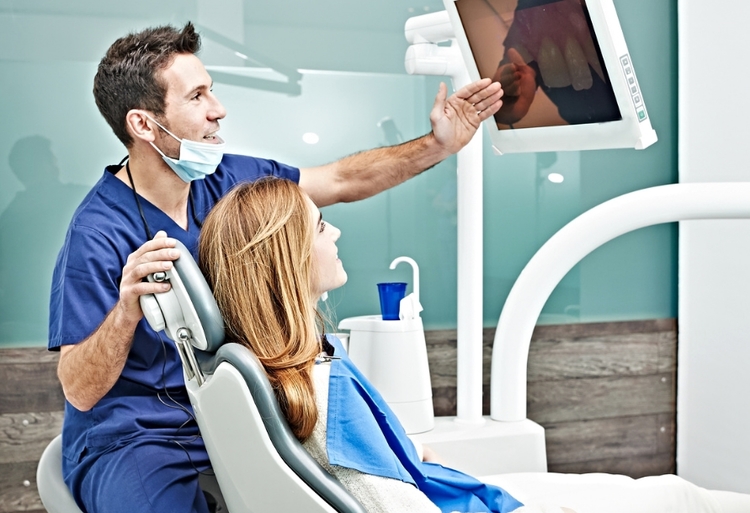"Oh, I just wanted my teeth cleaned." This question, along with, "But my teeth don't hurt?" are two common patient reactions to your recommendation for periodontal treatment.
We asked Dr. Jim Hyland, president and CEO of Oravital, to share his experience with helping patients understand what's really going on with their gum health. Enter Dr. Hyland...
When I ask patients what they want from their hygiene appointment, they say, “a cleaning that doesn't hurt”. What they don't say, but everyone wants, is to be healthy. Focusing on this area is your opportunity to grow your practice and improve your relationship with patients. 75% of patients have some form of gum disease defined as bleeding. Are our techniques really working?

Since patients’ gums often bleed and hurt when we scale but not during their home cleaning, it becomes our fault in their eyes. Patients don't fully understand their oral health status and cannot relate it to the bleeding. As well, we have tended to minimize bleeding because it has been so difficult to get patients healthy. Healthy skin and gum never bleeds when touched. When we use a razor the skin doesn't bleed nor does it when we scratch.
A good method to demonstrate bleeding is using the Papillary Bleeding Score. Consider using a Soft-Pick® to demonstrate bleeding by pressing it between teeth before you scale. When patients see the blood around the sulcus they know this is not normal and they want it fixed.
Now is the time to ask “is your mouth kissable"? "Do you know how you get gum disease?"
Explain that gum disease is an infectious, contagious, even sexually transmitted disease that begins as salivary transfer from the caregiver (usually the mother) and continues each time we kiss someone or share food. Explain if gums bleed there is a wound. Blood from someone else's mouth and bacteria from their saliva can enter these wounds if your gums are bleeding and travel throughout your body. Your patient will be shocked and motivated to get healthy. Now they know what’s in it for them. Bleeding matters!
If there is a lot of bleeding, imagine explaining to a patient why we routinely take scalers used in an infected bleeding site and use these in healthy sites. Consider using a chlorhexidine rinse before every dental appointment and irrigate the sulcus of the bleeding areas with chx prior to scaling to disrupt the pathogenic biofilm.

Using a disclosing solution will reveal where these biofilms are located and make it “real”. You can't expect someone to clean a room blindfolded and patients can't see biofilm so they don't recognize they have a problem unless you reveal its presence. If disclosing reveals biofilm, patients can't deny its existence and they are more open to changing their technique that is not effective if biofilm is present.
When discussing treatment, tell your patient "think of your condition as a sliver in your finger. Do you want me to treat your symptoms or shall we pull the sliver out and eliminate the problem”? Everyone says pull it out.
Now patients are listening to you and you can present a plan to get them healthy.
Ask if you can tell them a story about the Oral Systemic Link and relate this to their medical and dental health. Tell them that if their gums bleed they may be at risk for systemic conditions because the infection spreads from the infection in the gums throughout the whole body. Discuss the similarities between spirochetes that cause bleeding gums and spirochetes responsible for Lyme disease and Syphilis, conditions that result in dementia. There is new evidence that 94% of patients with Alzheimer’s disease have spirochetes in the brain that are identical to those causing periodontal disease. Bleeding gums indicate that those bacteria are present in the mouth and you are at risk for this condition. Ask them if they want to stop the bleeding.
Explain to patients that periodontal disease has been identified as a risk factor for cardiovascular disease that is equivalent to high cholesterol and high blood pressure. 33% of blood clots from heart attacks have live gum disease bacteria in them. A physician has a zero tolerance for bleeding and as a profession we need to do the same.
Have you considered that our message on oral self-care may be wrong?
We emphasize, “brush your teeth and floss” but only 8% of patients really floss! Teach your patient to brush the gums at the gingival margin rather than “clean the teeth”. Demonstrate this with the brush in the patient’s hand after you have disclosed the biofilm. Keep in mind patients have done their best to clean before they come to the office. If there is disease, it doesn't matter how often they clean or for how long. We need to improve their technique.
Now ask your patient if you could show another method of cleaning between the teeth that is more effective than flossing. 100% of your patients will say “yes”. Demonstrate softpics/stimudents and they will love you! Remember biofilm clings to tissues as firmly as the tooth and it requires firm pressure to disrupt it sufficiently from both surfaces. Soft-Picks® and Stim-U-Dents are more effective than floss in removing interproximal biofilms. Flossers bleed when they start using Soft-Picks®. The objection to Soft-Picks® is that their use can cause tissue shrinkage. This is true if there is infection. The beer belly gums shrink as they take on a healthy six-pack abs look. Rubbed tissue doesn't shrink it calluses. Bleeding and soreness go away on the third day.


Do all this before picking up an instrument. Reinforce that getting healthy is a process not a destination. Remind your patients that you are there to coach them in getting healthy. Your patients will appreciate you. Everyone wins.
Patients are healthy. Restorative care is easier with no bleeding. Hygienists become healers not cleaners, and your practice will grow on every level.
Future blogs by Dr. Hyland will discuss how to stop the bleeding by incorporating oral antibiotic rinses and laboratory biofilm diagnosis, new verbal skills to motivate patients, understanding the cause of breath odor and how to effectively treat this condition and the four objective tests to demonstrate health or disease to patients.
Thanks to Dr Jim Hyland for this blog post.

Dr. Hyland believes that getting patients healthy is our primary responsibility. It starts with effective biofilm control. He started www.Gumguardians.com to provide a patient information website about gum health and care. He is also president and CEO of Oravital, a company that provides coaching to hygiene teams in transforming the patient experience and a system to control bacteria that causes periodontal disease and breath odor. www.oravital.com.
 (800) 691-7234
(800) 691-7234 answers@dw-corp.com
answers@dw-corp.com PRACTICE LOGIN
PRACTICE LOGIN










